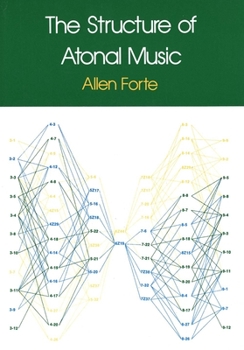The Structure of Atonal Music
Select Format
Select Condition 
Book Overview
"For some years now, a group of American composers and theorists including Babbitt, Teitelbaum, Martino, and Lewin, have been elaborating mathematically based procedures for the analysis of pitch... This description may be from another edition of this product.
Format:Paperback
Language:English
ISBN:0300021208
ISBN13:9780300021202
Release Date:September 1977
Publisher:Yale University Press
Length:240 Pages
Weight:1.08 lbs.
Dimensions:0.7" x 7.0" x 10.0"
Customer Reviews
5 ratings
A Musician's View
Published by Thriftbooks.com User , 15 years ago
This book is paramount literature for the instruction and understanding of the fundamentals of atonal music. It is written in great detail with careful tempering concerning the reader. An essential must for the library of any musician studying the concepts of pitch-class and atonal music principles.
Math Phoney
Published by Thriftbooks.com User , 18 years ago
I can't comment on Forte's book, since it was not *my* introduction to musical set theory. However, I would like to respond to a rather stupid reviewer from Nov. 11, 2001, who seems to believe that cardinality is a concept unique to infinite sets (in mathematical set theory). This is simply not the case. Finite sets have cardinality as well (e.g. the set {X,Y,Z} has a cardinality of 3} . In fact, the concept of cardinality for infinite sets is far more tenuous than it is for finite sets, and due to problems such as the independence of the continuum hypothesis, some philosophers and mathematicians speculate that infinite cardinality may be an untenable concept. Most do not agree, but it is certainly misinformed to criticize Forte for introducing the concept of cardinality to musical set theory with finite sets of pitches. As to the reviewer from Nov. 27, 2001, if you don't agree with the material, why'd you pick up a book on atonal theory in the first place? You should be commenting on whether this is a good intro to atonal theory, not the merits of atonal theory itself. For that, you may feel free to argue with a sock puppet.
Music, not math
Published by Thriftbooks.com User , 20 years ago
Forte's book is, as its title suggests, a work onatonal music. In this role, it is regarded as animportant and seminal work. While it uses a quantitativelanguage, as does all music theory, and indeed musicitself, it is not a treatise on mathematics.A few reviews below have criticized Forte for what are claimed to be mathematical flaws. As a researcher witha PhD in mathematics and a side interest in composition,I'd like to counter this. As long as Forte is analysingmusic, and not claiming to prove Fermat's Last Theorem,I'm happy to let him use whatever terminology suits hispurpose. I am no more concerned about his set theory than I am whether classical harmony is a good number system.Pedantry about mathematical terminology in this context may sound impressive to non-mathematicians but is likely based on shallow knowledge/understanding of mathematics. More importantly, it certainly distracts from the central focus, which is how well Forte's framework contributes to understanding and composing a certain kind of music.In particular, a review titled "quackery" below has been found useful (as of this writing) to 5 of 8 readers. The "quackery" reviewer cites the use of the term "cardinality" as an abuse of mathematical terminology when applied to finite sets. In fact, applying "cardinality" to finite sets is commonplace, about as controversial as using stringed instruments in an orchestra.
Very Objective and Approachable Writing Style
Published by Thriftbooks.com User , 24 years ago
Sorry, I beg to differ with both "fatuous" and "childish and absurd". As an aspiring composer who is not a formally trained instrumentalist, and is not formally trained, but self-taught, in music theory, this book is FAR more objective than Perle's (I didn't even finish reading Perle's, the writing style was so opaque), and doesn't assume either the ability to read music or an affinity for Schoenberg, Berg and/or Webern. Plus the writing style is way more transparent. Perle's book is mostly a musicological piece, not an objective assessment of available musical materials.
fatuous
Published by Thriftbooks.com User , 24 years ago
Among the crimes committed by this book are abuse of punctuation and terminology. I was fairly far into this before I realized that by "pcs" its author didn't mean "pitch class set" (or post-coital syndrome), but "pitch classes". Had he checked any elementary grammar guide, he would have learned that the plural of this sort of abbreviation requires an apostrophe: not "pcs", but "pc's". Also: tetrachords and hexachords are contiguous segments of a scale, melodic pattern, or tone row, not arbitrary four-note and six-note "pitch collections". What the author calls "tetrachords" and "hexachords" are really tetrads and hexads. He should call them tetrads and hexads. I wouldn't make so much of these solecisms had this book any real content. Oh, well.I too recommend PENTATONIC SCALES FOR THE JAZZ-ROCK KEYBOARDIST by Jeff Burns.




